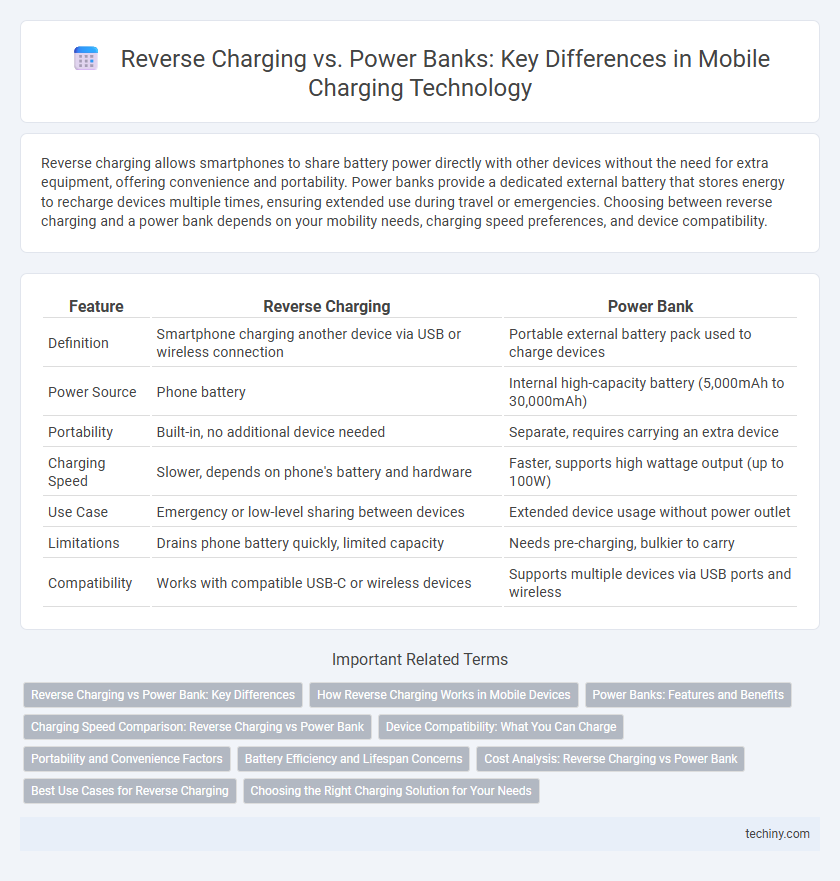Reverse charging allows smartphones to share battery power directly with other devices without the need for extra equipment, offering convenience and portability. Power banks provide a dedicated external battery that stores energy to recharge devices multiple times, ensuring extended use during travel or emergencies. Choosing between reverse charging and a power bank depends on your mobility needs, charging speed preferences, and device compatibility.
Table of Comparison
| Feature | Reverse Charging | Power Bank |
|---|---|---|
| Definition | Smartphone charging another device via USB or wireless connection | Portable external battery pack used to charge devices |
| Power Source | Phone battery | Internal high-capacity battery (5,000mAh to 30,000mAh) |
| Portability | Built-in, no additional device needed | Separate, requires carrying an extra device |
| Charging Speed | Slower, depends on phone's battery and hardware | Faster, supports high wattage output (up to 100W) |
| Use Case | Emergency or low-level sharing between devices | Extended device usage without power outlet |
| Limitations | Drains phone battery quickly, limited capacity | Needs pre-charging, bulkier to carry |
| Compatibility | Works with compatible USB-C or wireless devices | Supports multiple devices via USB ports and wireless |
Reverse Charging vs Power Bank: Key Differences
Reverse charging enables devices such as smartphones to share battery power directly with other compatible gadgets through USB-C or wireless connections without extra accessories. Power banks are portable external batteries with dedicated capacity ratings, used to recharge multiple devices on the go and often include multiple output ports for simultaneous charging. Unlike power banks, reverse charging depends on the donor device's remaining battery and may deplete its charge faster, making it ideal for emergency use rather than prolonged power supply.
How Reverse Charging Works in Mobile Devices
Reverse charging in mobile devices enables one phone to act as a power source, supplying energy to another device via a direct USB or wireless connection. This functionality leverages the device's battery and charging circuitry to transfer power, often utilizing USB-C or Qi wireless standards for efficient energy exchange. Unlike power banks, which are standalone external batteries, reverse charging is integrated into the smartphone hardware, allowing on-the-go power sharing without carrying extra accessories.
Power Banks: Features and Benefits
Power banks offer portable, high-capacity energy storage that enables extended device use without reliance on fixed outlets, supporting multiple devices with versatile USB and USB-C ports. Advanced features include fast charging technologies like Qualcomm Quick Charge and Power Delivery, digital displays indicating precise battery levels, and compact, lightweight designs for easy transport. Benefits include reliable backup power during travel or emergencies, compatibility across smartphones, tablets, and wearables, and the ability to recharge via solar panels or USB, enhancing convenience and sustainability.
Charging Speed Comparison: Reverse Charging vs Power Bank
Reverse charging typically offers slower charging speeds compared to power banks, as it relies on a device's limited battery output and often uses lower wattage. Power banks are designed with higher capacity cells and optimized circuitry, enabling faster and more consistent charging rates, sometimes exceeding 18W or even 45W with quick-charge technologies. For faster mobile device replenishment, power banks are generally more efficient than reverse charging methods.
Device Compatibility: What You Can Charge
Reverse charging enables direct power transfer between compatible smartphones and devices, supporting a range of gadgets such as earbuds, smartwatches, and other Qi-enabled electronics without extra accessories. Power banks offer broader device compatibility, charging virtually any USB-powered device including laptops, tablets, and cameras through multiple output ports. Understanding device compatibility ensures efficient energy use and convenience whether opting for reverse charging or a versatile power bank.
Portability and Convenience Factors
Reverse charging leverages a smartphone's built-in battery to wirelessly or wired charge other devices, offering unmatched portability by eliminating the need to carry extra equipment. Power banks provide higher capacity and multiple device charging but add bulk, impacting convenience during travel or daily commutes. Choosing between reverse charging and power banks depends on balancing immediate accessibility with extended power supply needs in mobile technology usage.
Battery Efficiency and Lifespan Concerns
Reverse charging offers convenience by allowing direct power transfer between devices but often results in higher energy loss and reduced battery efficiency compared to dedicated power banks. Power banks are engineered with optimized battery management systems that enhance charging efficiency and protect battery health, thereby extending the lifespan of both the power bank and the device being charged. Frequent use of reverse charging can accelerate battery degradation due to increased heat generation and inconsistent power delivery, making power banks a more reliable choice for sustained battery longevity.
Cost Analysis: Reverse Charging vs Power Bank
Reverse charging eliminates the need for purchasing extra devices, offering a cost-effective solution by utilizing existing smartphones as power sources. Power banks require an upfront investment, ranging from $15 to $60 depending on capacity and brand, alongside potential replacement costs due to battery degradation. Evaluating long-term expenses, reverse charging reduces accessory dependency, while power banks provide higher capacity but involve recurring costs and maintenance.
Best Use Cases for Reverse Charging
Reverse charging excels as an on-the-go solution, enabling smartphones to share battery power directly without carrying extra devices, ideal for emergency top-ups during travel or outdoor activities. It is most effective between compatible devices, like smartphones with USB-C or Qi wireless charging, providing seamless power transfer when a power bank is unavailable or fully depleted. Reverse charging suits short-term energy boosts, whereas power banks offer prolonged charging capacity, making each option distinct in mobile power management.
Choosing the Right Charging Solution for Your Needs
Reverse charging uses your smartphone's battery to charge other devices, offering convenience for emergencies but reducing your own battery life quickly. Power banks provide a dedicated external battery with higher capacity, making them ideal for extended use or multiple device charges. Assess your daily usage patterns and portability needs to select between on-the-go reverse charging or a reliable power bank for sustained power.
Reverse Charging vs Power Bank Infographic

 techiny.com
techiny.com